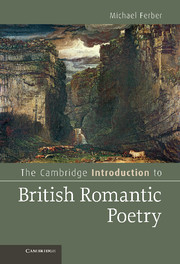Book contents
- Frontmatter
- Contents
- Preface
- Acknowledgments
- Chapter 1 Introduction
- Chapter 2 The poet
- Chapter 3 “Tintern Abbey”
- Chapter 4 Romantic odes
- Chapter 5 The French Revolution
- Chapter 6 Romantic sonnets
- Chapter 7 Romantic love lyrics
- Chapter 8 Romantic ballads
- Chapter 9 Romantic epics and romances
- Chapter 10 Romantic verse drama
- Chapter 11 Romantic satire
- Appendix
- Notes
- Further reading
- Index
Preface
Published online by Cambridge University Press: 05 June 2012
- Frontmatter
- Contents
- Preface
- Acknowledgments
- Chapter 1 Introduction
- Chapter 2 The poet
- Chapter 3 “Tintern Abbey”
- Chapter 4 Romantic odes
- Chapter 5 The French Revolution
- Chapter 6 Romantic sonnets
- Chapter 7 Romantic love lyrics
- Chapter 8 Romantic ballads
- Chapter 9 Romantic epics and romances
- Chapter 10 Romantic verse drama
- Chapter 11 Romantic satire
- Appendix
- Notes
- Further reading
- Index
Summary
Preface
The texts of poems which I quote in their entirety are taken from facsimiles or older editions no longer in copyright, or from Literature Online, which also uses texts in the public domain. I have usually checked them against more recent editions and found only slight variations in spelling or punctuation. I have sometimes modified the source text in ways that agree with recent editorial practice, for example, changing “oh” to “O” several times in Shelley’s “Ode to the West Wind” (“oh” seems more appropriate to an exclamation, “O” to a direct address, though they are arguably both at once). Occasionally I discuss variations in punctuation where they might bear on how we interpret a passage, for example, the final two lines of Keats’s “Ode on a Grecian Urn,” but by and large the variations seem of small importance in an introduction to the poems.
In the Further Reading section I recommend good (and affordable) recent editions of each poet. A few of these are the scholarly standard, but in some cases, such as Coleridge, the most exactingly edited editions are too cumbersome (and expensive) for most readers. That is not to deny that the different editorial philosophies invoked by different editors make for interesting debates: Use the earliest version of a poem or the latest, or something in between? Correct the final printed version with probably intended emendations in a notebook, or let it stand? Modernize punctuation and spelling or keep it in the original form? Indent lines to reflect the rhyme scheme or not? Readers of this book needn’t worry about these issues, but if they find something ambiguous or puzzling in any of the texts, they might find something intriguing about it if they look it up in the modern scholarly editions.
- Type
- Chapter
- Information
- Publisher: Cambridge University PressPrint publication year: 2012

